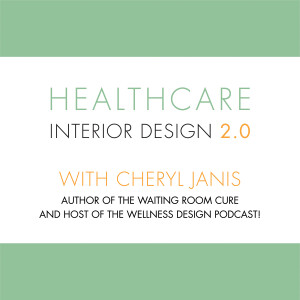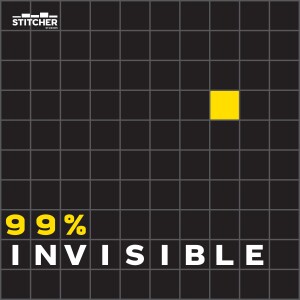
Healthcare Interior Design 2.0
Arts:Design
In Part 1 of today’s episode, Cheryl speaks with Roderic Walton, AIA, NOMA, NCARB; Principal at Moody Nolan - the nation’s largest African American architecture firm. Cheryl and Roderic dive deep into the topic of race in healthcare and architecture. Cheryl asks Roderic what it’s like to work for the nation’s largest African American architecture firm. Roderic shares, “My individual performance is often represented as that of the entire African American community by so many people that I interact with, and it can be overwhelming. There are so few black architects practicing today and what that means is that often I am the only person of color who is in a leadership role, and looks like me, in most of my professional interactions.” Learn more about what the experience is like for people of color when they enter the healthcare space and why there is a direct correlation between what communities African Americans live in and the type of healthcare they receive, and how healthcare design and architecture professionals can truly change this. Tune in to part 1 of this deeply informative, compassionate and engaging interview with Roderic Walton.
Learn more about Roderic Walton,and Moody Nolan by visiting: http://moodynolan.com/.
Read Roderic Walton’s white paper entitled, “Equity in Healthcare: Healthcare in Black America, ‘Where We Are’ The Current State of Healthcare in America.” here: https://www.nomanash.com/healthequity2 and here: https://www.nomanash.com/healthequity3
In Part 1 of Cheryl’s conversation with Roderic Walton they discuss:
- What is it really like for Roderic (a person of color) to work for the nation’s largest African American architecture firm -- Moody Nolan -- who, among other areas of focus, address issues of disparity and uplift communities that have been disenfranchised?
- The story of Roderic’s early experience of racism in the field of architecture and how this was a wake-up call that race was going to be an issue.
- What led to Roderic’s decision to write a powerful white paper entitled, “Equity in Healthcare: Healthcare in Black America, ‘Where We Are’ The Current State of Healthcare in America?”
- Roderic’s white paper unpacks the complex relationship between racism, redlining, and the current asymmetry in health outcomes for Black and other minority communities. Here are two links to this read this white paper: https://www.nomanash.com/healthequity2 and https://www.nomanash.com/healthequity3
- COVID has highlighted one vivid and easy-to-understand example of racial bias translating to real harm, and that is the way that pulse oximeters have reduced accuracy with dark-pigmented skin. Roderic shares other examples of harm resulting from bias — or outright racism — that listeners might be less aware of.
- What is the experience like for people of color when they enter the healthcare space?
- What is the direct correlation between what communities African Americans live in and the type of healthcare they receive?
- What was the foundation that was used to justify discrimination that we’ve seen historically?
- It's obvious to anyone willing to look that Black, Indigenous, and People of color are underrepresented in architecture. This is a group that is around 40% of the US population and 2% of architecture. What has contributed to this?
- Why has the healthcare design and architecture industry, despite some effort at diversity and inclusion, failed to make much improvement here?
- Roderic walks us through the journey that got him to where he is today.
- Why did Roderic pursue a career where he looks around a typical meeting room and sees so few people like himself?
- Moody Nolan was given the 2021 AIA Gold Medal and Firm Award. Roderic shares what this means to him and to his firm.
- How has Paul Revere Williams, the first certified African-American architect west of the Mississippi influenced the work that Roderic and Moody Nolan does today?
In part 2 of Cheryl’s interview with Roderic Walton, AIA, NOMA, NCARB; Principal at Moody Nolan, Cheryl asks Roderic the question, “When thinking about the future, how can healthcare design and architecture professionals begin to change entrenched systems that are the source of some of these race-related problems?” Roderic shares, “The solution starts with an understanding that it’s not just about individual folks solving their own problems, picking themselves up by their bootstraps and overcoming centuries of oppression. The study of history is clear, it’s instructive; we have a collective responsibility to address these types of concerns. Architects can become active participants in community engagement and outreach activities, and really position ourselves as being much more inclusive and receptive to the notion that we have elective responsibility here to address these issues of oppression. And because we are architects does not mean the problem lies outside of our industry. We are part of the solution.” This and so much more on the changing face of healthcare design on part 2 of today’s episode with Roderic Walton now available.
The world is changing quickly. The Center for Health Design is committed to providing the healthcare design and senior living design industries with the latest research, best practices and innovations. The Center can help you solve today’s biggest healthcare challenges and make a difference in care, safety, medical outcomes, and the bottom line. Find out more at healthdesign.org.
Additional support for this podcast comes from our industry partners:
- The American Academy of Healthcare Interior Designers
- The Nursing Institute for Healthcare Design
Learn more about how to become a Certified Healthcare Interior Designer® by visiting the American Academy of Healthcare Interior Designers at: https://aahid.org/.
Connect to a community interested in supporting clinician involvement in design and construction of the built environment by visiting The Nursing Institute for Healthcare Design at https://www.nursingihd.com/
Thank you for listening to today’s episode of Healthcare Interior Design 2.0. If you enjoyed any part of Cheryl’s conversation with Roderic Walton, please help our podcast grow by spreading the good word on social media and with your online community. Stay safe and be well. For the full roster of shows, visit http://healthcareidpodcast.com.
FEATURED PRODUCTInspired by the properties of photocatalytic materials, Porcelanosa has evolved their KRION® Solid Surface material called K-LIFE. When K-LIFE comes into contact with light, it will be able to purify the air, expel harmful bacteria, and more. K-LIFE can easily be integrated into many applications – from wall coverings and claddings for ceilings, to custom tables, bars, sinks, shelving units and furniture. The application of K-LIFE in areas with high daily traffic, such as waiting rooms or reception areas, can assure a gradual decontamination of germs and lead to ongoing ecological benefits. Some research performed with KRION® K-LIFE, which has photocatalytic properties, proved that the material can significantly reduce the presence of bacteria. This revolutionary process has led to a patent pending, innovative, and exclusive product that will have a direct effect on our quality of life. Watch the video on KRION Natural Infection Prevention.
More Episodes
13, Part 2: Scott McFadden
 2019-06-14
2019-06-14
12, Part 2: Avigail Eisenstadt
 2019-05-24
2019-05-24
12, Part 1: Avigail Eisenstadt
 2019-05-24
2019-05-24
11: Aimee Burmaster Hicks
 2019-05-10
2019-05-10
10: Rebecca Rothstein
 2019-04-19
2019-04-19
9: Kristin Zeit & Jennifer Kovacs Silvis
 2019-03-20
2019-03-20
8: Tiana Lemons
 2019-02-14
2019-02-14
7: Jocelyn Stroupe
 2019-01-31
2019-01-31
6: Rebecca Brennan
 2019-01-16
2019-01-16
5: Joanna Frank
 2018-12-20
2018-12-20
4: Dr. Richard Jackson
 2018-12-07
2018-12-07
3: Jane Rohde
 2018-11-19
2018-11-19
2: Libby Laguta
 2018-11-06
2018-11-06
1: Ana Pinto-Alexander
 2018-11-06
2018-11-06
Create your
podcast in
minutes
- Full-featured podcast site
- Unlimited storage and bandwidth
- Comprehensive podcast stats
- Distribute to Apple Podcasts, Spotify, and more
- Make money with your podcast
It is Free
You may also like

99% Invisible


The John Clay Wolfe Show


The Real Time Show


Just So Stories


The Art of War


How to Decorate


Design Better


- Privacy Policy
- Cookie Policy
- Terms of Use
- Consent Preferences
- Copyright © 2015-2024 Podbean.com



 iOS
iOS Android
Android